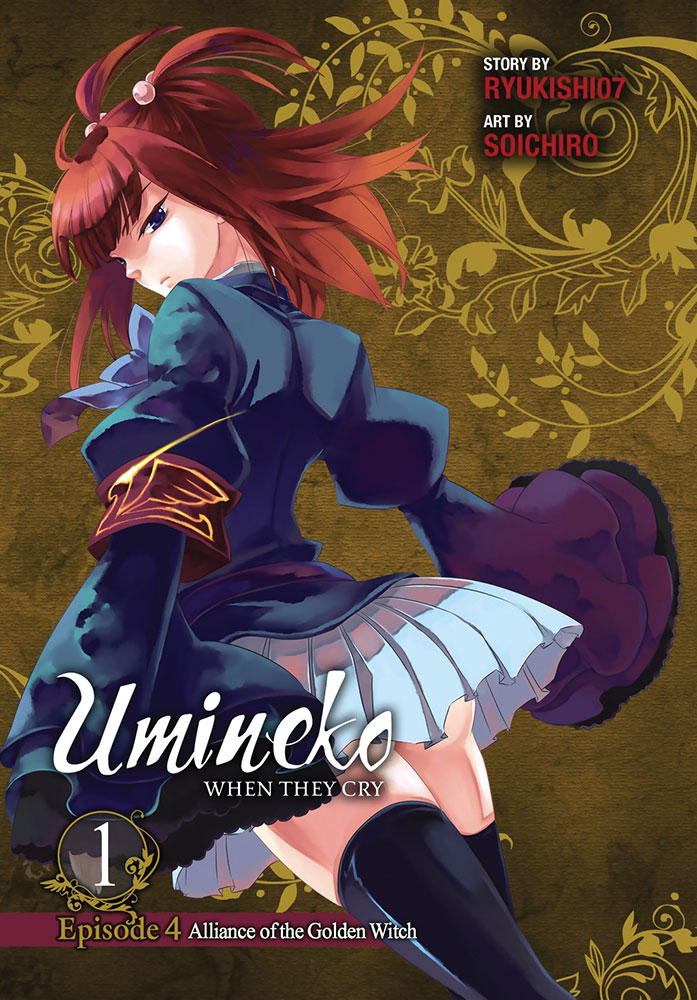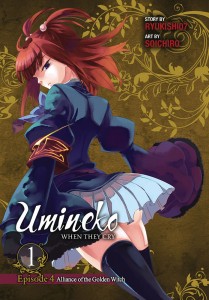Story by Ryukishi07; Art by Soichiro. Released in Japan in two separate volumes as “Umineko no Naku Koro ni: Alliance of the Golden Witch” by Square Enix, serialized in the magazine Gangan Online. Released in North America by Yen Press.
Umineko is in many ways a dark mirror of Higurashi: When They Cry, and so it makes sense that we would switch protagonists at this point. In Higurashi, after three arcs following the POV of Keiichi Maebara, the fourth arc gave us a new character, Mamoru Akasaka, and saw how he interacted with a younger Hinamizawa during the dam wars. Umineko likewise switches away from Battler to a degree, bringing his younger sister Ange, now an 18-year-old, into the story. Ange is a lot more invested in what happened on the island, though, and is also far more biased in her viewpoints than Akasaka was. The first 4/5 of this book deal solely with Ange in two different time periods: as a teenager being bullied in her private school (the same school Shion attended, by the way), and as an 18-year-old in 1998, dealing with the fallout from Eva’s death and trying to find out what happened 12 years earlier.
The first thing that comes to mind about this adaptation is how rearranged everything is from the original sound novel. In the Alliance novel, we intersperse Battler and Beatrice’s game with Ange throughout, never losing sight of their part in the narrative. Here, we get nothing but Ange (and Maria) for almost the entire volume, only coming back to Beatrice right as Ange is joining their game as “Gretel”. It makes it seem like this has become Ange’s story. But unlike Higurashi, where switching to a story focused on Rika showed off how she was becoming the main protagonist soon, Ange is never quite going to be the star. A large part of the narrative, yes, but it’s Beatrice and Battler’s story. Unlike, say, Kino no Tabi, it’s clear that Ryukishi07 approved of the rearranging of events here. But it does mean that we approach things from a different perspective, downplaying what’s happening in 1986 in favor of the events of 1998.
Speaking of that, while Higurashi had a brief manga-only flash-forward showing a surviving Shion trying to go on after everyone’s death, the main storyline of the visual novels never quite showed off a future of “everyone is dead and you really can’t change the future easily at all” like this does. Bernkastel notes she’ll search for a fragment where Ange’s family survives, but that it’s odds are infinitesimally small. Ange and Battler are both approaching the narrative, albeit in different ways, in a Higurashi perspective: if I figure out what happened, I can fix it so it never does. Umineko being partly a deconstruction of Higurashi, it’s not going to be as simple as that.
Be warned there is a lot of discussion of bullying here, both of Maria and Ange, though Ange gets the brunt of it. It’s actually intertwined with the discussion of magic, and who has the potential to be really good at it. Much as the 3rd arc was excellent at showing us what “Beatrice” can really be, this arc delves into the actual state of “magic” in the Umineko world, and what it can be used for. Ange gets to the point where she can conjure up one of the Seven Stakes, Mammon, to float around with her and be her friend, but she can’t really interact with anything. This is in contrast to Maria, who can make a stuffed bear like Sakutarou come to life, or Beatrice, who can then give Sakutarou human form.
Aside from moving events around a bit, there are a few things I’m a little annoyed about with this adaptation. The fanservice which is never too far away from all of Ryukishi07’s works is shown off a lot here, possibly in celebration of the fact that this volume doesn’t have to deal with the adults at all. Right on the front cover we see a flash of Ange’s ass, and the stakes, particularly Mammon, are very fond of showing off their bodies to the reader. And while the sound novel has Ange discussing getting her family back quite a bit, the manga makes it seem several times as though it’s Battler who she’s really concerned with. This, of course, allows her to have a “brother complex”, one of Japan’s favorite motifs.
I haven’t mentioned the non-island adults in this volume, several of whom may surprise Higurashi readers. Okonogi is back, and this time he seems to be Ange’s ally… although, being Okonogi, he’s also Kasumi’s ally as well. Ryukishi07 enjoys playing with his readers like this, particularly as the Higurashi reader is inclined to mistrust everything he says, just as they’re drawn towards Bernkastel as “Rika”. Ange’s bodyguard was also spotted in the final Higurashi manga, though there he was working for the enemy trying to kill our heroes. Phew. Thank God he’s on Ange’s side now. As for Kasumi Sumadera, Kyrie’s younger sister, she’s shown to be almost completely insane from the get go. Which does at least lend itself to some amusing expressions.
As we wrap up this first omnibus, we’re about to start the game proper at long last, leading one to wonder if this one will finally let us see Kyrie the way the other three arcs focused on Natsuhi, Rosa and Eva? Will battler, with the addition of Ange/Gretel, be any better at figuring things out from the hints Beatrice drops? Will Beatrice and Battler continue to be an adorable love/hate couple? What the hell does Bernkastel want here? And can Ange, Maria, or Beatrice manage to escape the situations that have left them in despair? We’ll see next time around.

